In the most highly anticipated religious festival of the year, women came from far and wide to gather in their cities to celebrate the Thesmophoria, the oldest and most widespread of all ancient Greek religious festivals. Comprising as many as 50 cities; it spanned from Sicily in the west to Asia Minor in the east; from Macedonia in the north to North Africa in the south. Scholars believe that its expansive nature within the Greek world is testament to its prehistoric origins. Primarily a fertility cult, the Thesmophoria ushered in the sowing season and was one of a series of fertility cults devoted to human as well as crop fertility. In Athens, it was celebrated in the month of Pyanopsion (October-November) on the 11th through the 13th in the area known as the Pnyx—a prominent hill where the general assembly of the polis met. On the second and most sacred day of the Thesmophoria, there was a cessation of certain civic functions reflecting men’s reverence for the feminine cult.
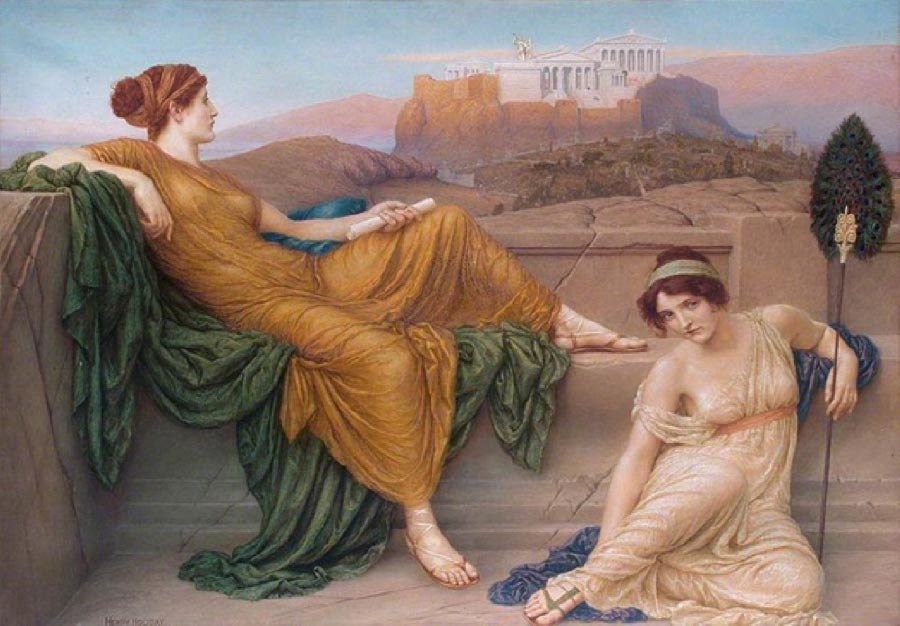
Aspasia on the Pnyx by H. Holiday (1888) (Public Domain)
Greek Citizen Wives
Why was a women’s fertility festival in hyper-patriarchal ancient Greece, given such prominence in greater society? After all, in ancient Greece women’s place was on the margins of society, away from the public sphere. Could the strict demarcation of gender roles actually serve to empower women in ancient Greece? The disciples of the Thesmophoria formed an identity around the cult, which served to promote a feminine consciousness, uncommon in the androcentric dominion of ancient Greece. Against the backdrop of extreme misogyny, men developed an esteem for the Thesmophoria.
Membership in the Thesmophoria was restricted to citizen wives, that is to say, wives of male citizens. Make no mistake, there were no female citizens in ancient Greece. Greek women married to male citizens were called citizen wives because they reproduced the ever-coveted male citizens. Further, no maidens nor female slaves were allowed to participate in the Thesmophoria. And last but not least, men were strictly prohibited from enjoying any portion of the festival. Unlike other feminine fertility festivals, women of the Thesmophoria made sacrifices (much as men did in festivals) and so used instruments of death in their ritual. Because of this and other subversive elements in the festival, men who spied on the event risked life and limb by doing so. Although typically confined to the seclusion of their domiciles, women celebrated the Thesmophoria away from their domiciles and families for a minimum of three days and three nights—noteworthy in and of itself. In Syracuse, it was celebrated for 10 days and nights.
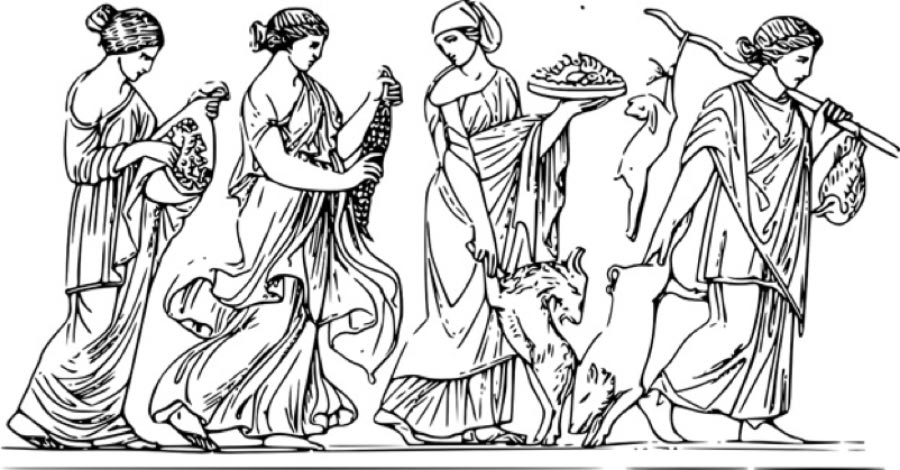
Citizen wives preparing food in Ancient Greece (CC0)
To appreciate the significance of a feminine only cult festival garnering esteem from the entire community—including its male citizens who not only supported it but backed it financially—it is important to get a glimpse into what life was like for women in ancient Greece. To be sure, a woman’s place was in the home tending to such things as nursing children, weaving clothing and preparing food. Unless they were priestesses they could not participate in the public life of the polis in any way. Once married, not only were women confined to the domicile, but they were considered lifelong minors whose every move was directed by their husbands. Even the simple task of shopping was forbidden because women could not be entrusted with financial transactions as complicated as purchasing fruits or vegetables. Needless to say, if a woman could not be entrusted with the simple act of making change there was no question of giving them the vote in this newly democratized society. In consideration of the poor opinion men had of women, how did women’s alignment with the natural world then serve their better interests?

Gold ring from Isopata tomb, near Knossos, Crete, 1400–1500 BC. Depicted are female figures dancing among blossoming vegetation; Heraklion Archaeological Museum (CC BY-SA 3.0)
An Agrarian Society
When one envisions ancient Greece, one imagines it being the seat of Western civilization, yet for all its seemingly urbane sophistication it was chiefly an agrarian society where most of its residents worked the land. Because the land tended to be non-arable, the ancient Greeks were obsessed with the notion of fertility, finding it necessary to have several fertility festivals throughout the year. The fertility festivals were a means of garnering control and appeasing the gods in order to encourage fertility. However, the abundance of crops was not the only concern of the Greeks. Due to their ever-expanding empire, they needed an ample supply of men to maintain their military commitments, and they needed women to produce the much-coveted male citizens. As such Demeter—goddess of the harvest—was the chief fertility deity who was honored for her role in both crop and human fertility.
Demeter and her daughter Persephone played important roles in the myth which may have resonated with the women of ancient Greece. The oldest and most complete version of the myth comes from the Homeric Hymn to Demeter (hereafter called the Hymn) composed in the seventh century BC. Most scholars today believe that the Hymn invokes the Thesmophoria meaning that the Thesmophoria was practiced long before the Hymn was composed. Nevertheless, the Hymn is the key to understanding the climate in which the Thesmophoria was practiced. Living under their husbands’ patriarchal thumbs, wives had become accustomed to being out of the loop regarding the matrimony of their daughters. It was not unusual for a father to bargain with his future son-in-law about the fate of his daughter without the knowledge or consent of either mother or daughter.

Sarcophagus with the Abduction of Persephone by Hades. Walters Art Museum (CC BY-SA 3.0)
Hymn to Demeter
It was in the Hymn that Zeus, Persephone’s father, arranged with his brother Hades—lord of the Underworld—to kidnap, that is to say marry his daughter Persephone. One day while Persephone was out picking flowers with her friends, the earth cleaved open and Hades—on a horse drawn chariot—charged out violently snatching Persephone to be his wife in the Underworld. The kidnap or rape was the event, which spurred the action of the myth and it was this kidnapping cum marriage, which closely resonated with the women of ancient Greece, whose marriages were likewise orchestrated in this fashion.
In fact, in patriarchal ancient Greece, marriage was patrilocal, meaning that the young wives were forced to reside in their new husbands’ homes, sometimes miles away from their natal homes. Hence having contact with their family members was a rare occurrence. In this way then marriage was like a sort of death; as one sees Persephone whisked away to the Underworld, symbolically dead. Torn from her natal home—typically no older than 15 years of age—she was forced to marry an unknown man who was twice or three times her senior. In this case, abduction can be seen as the equivalent of rape. It was because of this unjust and cruel life experience that women could identify with the myth and find encouragement in Demeter’s strength and resolve.
As a result of Persephone’s cruel abduction to the land of the dead, Demeter is inconsolable. She roams around earth and has experiences with mortals but in the end, she refuses to be pacified. Finally, she realizes her true power lies in her fertility. So, she stops the seasons. And the fertile earth becomes a barren wasteland. Reluctant to see the planet he shepherds wither away, Zeus pleads with Demeter to make the earth abundant once again. But Demeter will not relent until Persephone is released. Finally, Zeus intercedes with Hades on Demeter’s behalf and orders him to return Persephone to her earthly abode. Hades adheres but not before luring Persephone into eating a pomegranate seed. The mere act of eating in the Underworld binds Persephone to Hades as his wife for a few months out of every year. Although males are present in the account, the Hymn is a woman’s story. All the major roles are played by females and the areas of concern: marriage and agriculture, are indubitably in the female domain.

The return of Persephone, by Frederic Leighton (1891) (Public Domain)
Of the Hymn, Carl Jung argues: “Demeter-Kore (Kore means young girl in ancient Greek and is how Persephone is known before the rape) exists on the plane of mother-daughter experience, which is alien to man and shuts him out. In fact, the psychology of the Demeter cult has all the features of a matriarchal order of society, where the man is an indispensable but on the whole disturbing factor.” To be sure, the dark bargain made by the male deities is a misbegotten one, as the union produces no child and nearly brings an end to life on the planet. Although their actions drive the events, Zeus and Hades are remote shadows whose dark force propels the dissonance felt by mother and daughter. Daring to defy the will of the patriarch, Demeter does something never seen before in Greek mythology: she challenges Zeus and very nearly wins. For the majority of the year, Persephone lives with her mother in the light of her mother’s earthly domain.

Harvest of phalluses. Fertility symbol in agriculture. British Museum (CC BY-SA 4.0)
Neolithic Mother-Daughter Lineage
At its most fundamental level, the Thesmophoria celebrated Persephone’s journey from her descent into the Underworld to her resurrection and life on earth. At a symbolic level relating to agriculture, Persephone is a metaphor for the seed, which in the Mediterranean region goes underground or lies dormant in the summer months only to be released again for planting in autumn. In ancient Greece, the grain-seed was buried in bins in the earth, then opened and distributed during the sowing season for planting. That being the case, Persephone represents resurrection and the regeneration of life; from life to death and back again each year. In point of fact, resurrection myths were often associated with fertility rituals. Demeter represents agriculture and her daughter Persephone represents vegetative regeneration; hence the mother and daughter dyad are closely linked symbolically as can be seen from artwork from the era. Some scholars believe that the mother and daughter are younger and older aspects of the same woman. In this way then the myth is about feminine transitions. After all, women could identify with either being mother or daughter or both mother and daughter.
Considered ancient even during the archaic period (800-480 BC), the Thesmophoria’s primeval rituals and its ubiquity in the Greek world have led many scholars to believe that its origins may come from as early as the Neolithic era, which in the Mediterranean region was around 7000-3200 BC. It is important to remember that what would become known as marriage did not exist during the Neolithic era. While it is unclear if society was ruled by women, most scholars agree that in the Neolithic era the social structure was matrilineal. Although the mother and daughter images can be found throughout the region, the father figure is largely missing. It is possible that paternity may not have been fully understood during the Neolithic era thus the mother/daughter relationship was primal. In a society that does not mate for life and assumes it ancestry through maternal lines, knowledge of paternity was not only incomprehensible but also possibly not necessary.
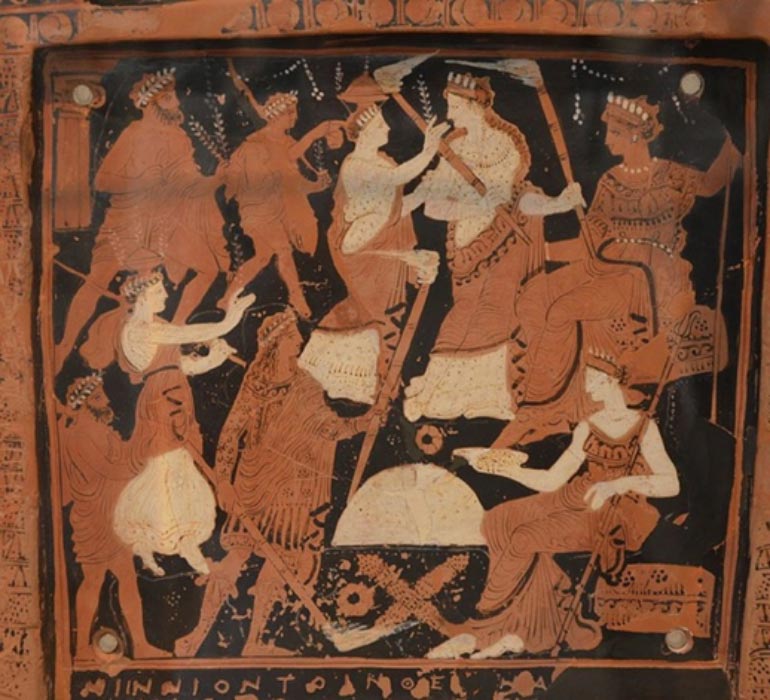
Votive plaque depicting elements of the Eleusinian Mysteries, discovered at the shrine of Eleusis. (CC BY-SA 2.0)
Medicinal Knowledge and Power
How did these prehistoric origins empower the citizen wives? The Thesmophoria bestowed a link to an era when women had autonomy in their lives; a time before patriarchal precepts ruled the land. Women played key roles during the Neolithic era which was known for the advent of agriculture and the raising of livestock. While men were hunting, women stayed behind foraging for plants; leading them to the cultivation of seeds and vegetation which ultimately became humankind’s principal foods and allowed them to settle land. Because of this gender specialization, women acquired an expertise in the use of plants which were not only appropriated for sustenance but also for its medicinal properties. Indeed, most men were not privy to the medicinal properties of plants. So, it should come as no surprise that women used the healing proficiency of plants for their reproductive health as well. By their astute use of plants, many scholars argue that the participants of the Thesmophoria determined just how fertile they wanted to be. The tight community that formed around the cult encouraged women to safely share information with each other not only on plant fertility but on human fertility as well.
Men supported the Thesmophoria because it was a fertility festival and ensuring a good harvest was vital for the health of the polis. Likewise, for the procreation of the prized male citizens, human fertility was just as important. But it is possible their wives had a different mindset about the festival. Archaeological findings and literary evidence reveal that through their expert utilization of different vegetation, women could manage every facet of their feminine well-being, including menstruation, conception, contraception, abortion, delivery, lactation and menopause. Because death from childbirth was common, there was significant motivation for women not to be overly fertile. That being the case many women may have acted to dissuade its occurrence.
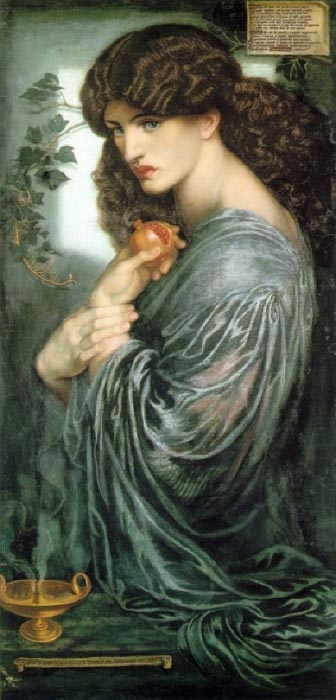
Persephone and the pomegranate by Dante Gabriel Rossetti (1874) (Public Domain)
So, while women of ancient Greece could not determine who their marriage partners would be, perhaps choosing amongst a variety of reproductive options—unbeknownst to their husbands—was one way that women took charge of their lives. Ironically, women’s restricted roles in ancient Greek society may have empowered them as most men had very little knowledge in the use of medicinal plants. This ignorance is portrayed in the Hymn when Hades entices Persephone to eat a pomegranate seed so she is bound to him for a few months each year. But Persephone has the last laugh. Unknown to Hades, the pomegranate seed has contraceptive qualities. Indeed, no child would spring from that unholy union.
In addition to finding empowerment through their expertise in medicinal plants, the rituals of the Thesmophoria were another means of promoting women. Because caverns represented the womb of Demeter, two women called ‘bailers’ descended into them to retrieve the decomposed remains of piglets, which had been sacrificed at an earlier time. In addition to the piglet remains, fertility cakes made from baked dough were also retrieved, along with pinecones which were used in the rite because they were known to be prolific. These sacred objects were then placed on the altar of the two goddesses and mixed with seed to produce what was known as ‘divine compost’. In an attempt to magically stimulate the fertility of the earth, farmers believed that mixing some of these sacred objects with their seed before sowing guaranteed a good harvest. In direct opposition to the gender oppression in the everyday lives of women in ancient Greece, the rituals in the Thesmophoria gave women license encouraging them to celebrate their reproductive powers.

A dedication to Bacchus by Lawrence Alma-Tadema (1889)(Notice the pomegranates on the table on the right) (Public Domain)
Secrets of the Thesmophoria
But how can one know the details of what transpired at the super-secret Thesmophoria? After all, the rituals were considered women’s mysteries and as such were covert and known only to the female participants. The oldest and best sources on the rituals are scholia found in the Lucian’s Dialogues of Courtesans. Scholia are explanatory comments found on the margins of ancient documents. There are many theories on who the Lucian scholiast may have been but the most intriguing is that it was one of the actors of the festival herself. After all, who else but an adherent to the Thesmophoria would have had knowledge of their super-secret rituals? Although finding empowerment was inherent in the rituals, women also found license within the organization of the Thesmophoria itself. While voting in the polis was out of the question for women of ancient Greece, membership within the Thesmophoria gave women a voice. The Thesmophoria was a politico-religious cult complete with elections. Forming an ad hoc type of democracy, the women were autonomous in their festival to make all decisions pertaining to the Thesmophoria such as planning, accounting and most importantly practicing feminine ritual—all without male counsel.

Part of the Parthenon frieze showing the procession that took place in the Panateneas. British Museum(CC BY-SA 2.5)
Woe the Men
Just as women were barred from the political sphere in ancient Greece, so they were barred from certain rites within the spiritual sphere as well. Unless they were priestesses, women were kept apart from altars, meat and blood. But in the Thesmophoria, the women performed sacrifices. They had to use knives and spits in their ritual which made their cult conspicuous. Although they supported it for pious reasons relating to the health of their land and their populace, men were threatened by the notion of independent women with access to the instruments of death. This male suspicion is evident in the legends about the violence against men who spied on their super-secret rituals. Some noteworthy examples of the violence that occurred to men who spied on or interrupted the Thesmophoria comes from ancient sources. First there is the lore that the hapless King Battus of Cyrene—famed for founding Cyrene—was cruelly castrated by the furious disciples for observing their secret and sacred rites. Then there is the tale of the legendary Messenian hero Aristomenes, who was celebrated for his victories against the fearsome Spartans. Unfortunately for him he didn’t fare as well against the women of the Thesmophoria. He was knocked senseless by their sacrificial knives and spits.
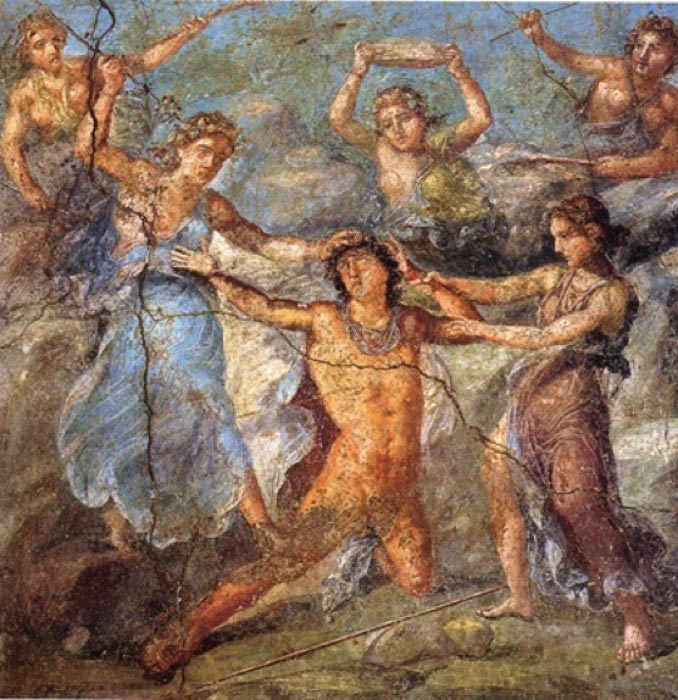
Maenads attacking Pentheus (Public Domain)
Next is the legend of the unlucky Miltaides, who while in battle to secure the island of Paros, leapt over the wall leading to the Thesmophorion shrine. Once there he was so overcome with terror that in jumping back over the wall, he sprained his thigh, from which he developed gangrene and later died. Greek historian, Herodotus, recounts this as an admonishment, and warns that Miltaides’ mournful outcome was due to his breaching the sacred sanctuary of Demeter Thesmophoros. Finally, there is Pesistratus, the tyrant of Athens and the Athenian states man Solon, pulling a trick on the women of the Thesmophoria by enlisting two beardless men to impersonate the disciples. Once discovered the women brutally attacked the wretched mimics. Could these legends be factual? In the end, whether these legends are historical or not is beside the point. What these stories all demonstrate are men’s profound uneasiness with the emancipated women of the Thesmophoria.
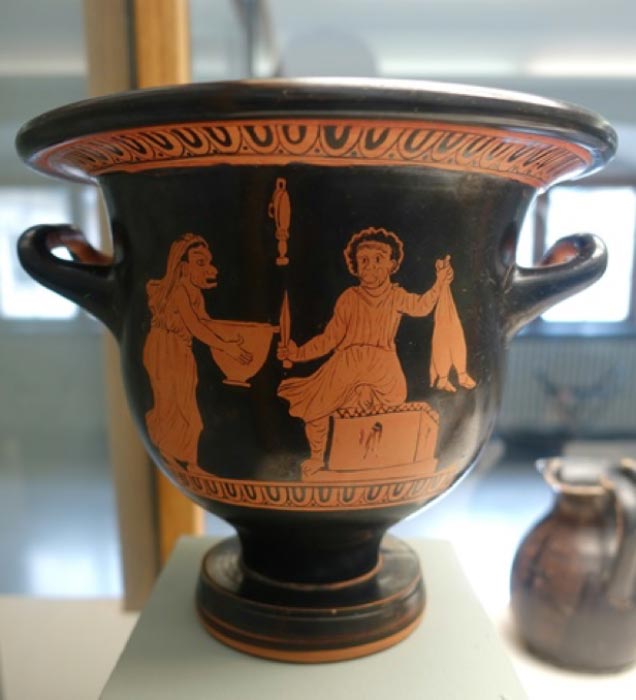
Apulian krater with scene from Aristophanes’ Thesmophoriazusae (c. 370 BC) (Public Domain)
A summary of stories about the Thesmophoria would be incomplete without mention of Aristophanes’ comedic satire Thesmophoriazusae or Women of the Thesmophoria. In it, Aristophanes casts his colleague Euripides as the character for whom the women of the Thesmophoria want revenge. “Today at the Thesmophoria the women are going to liquidate me, because I slander them,” exclaims Euripides. The premise is that the rebellious disciples seek to kill Euripides for characterizing women in his plays as villainous. While the women are mocked in terms of their ritual and democratic assembly in the play, Aristophanes’ depiction of the women of the Thesmophoria as uncontrollable and violent is in keeping with the patriarchal wary mindset toward the oldest and most subversive of all religious festivals.
Feminine Consciousness
In the final analysis religions may tell more about their adherents than their deities. After all, the characteristics of religions are often determined by the anthropological climate in which they are formed. This convention is most strongly evident with the feminine cult of the Thesmophoria. Harkening back to an era before being yoked to the patriarchal bond of marriage, women had agency in all facets of their lives which enabled the disciples to envision a new reality they might not otherwise possess in the hyper-patriarchal world in which they lived. Empowering a united feminine community without male restrictions, the independence of their foremothers promoted a feminine consciousness allowing women to take license in their lives. Confined to the margins of society, women had been denied all power except the one—essential power of childbearing—which differentiated them from men. Ironically it was this strict demarcation of gender roles that gave women the opportunity to exploit their fertility in order to harness power on their behalf.
Mary Naples’ master’s thesis: “Demeter’s Daughter’s: How the Myth of the Captured Bride Helped Spur Feminine Consciousness in Ancient Greece,” examines how female participants found empowerment in a feminine fertility festival. Visit www.ancientorigins.com
Top Image: Thesmophoria by Francis Davis Millet, 1894-1897 (Public Domain)
References
Blundell, S. 1995. Women in Ancient Greece. Cambridge: Harvard University Press.
Burkett, W. 1985. Greek Religion. Cambridge: Harvard University Press.
Detienne, M. 1989. The Violence of Wellborn Ladies: Women in the Thesmophoria. In The Cuisine of Sacrifice Among the Greeks. University of Chicago Press.
Goff, B. 2004. Citizen Bacchae: Women’s Ritual Practice in Ancient Greece. University of California Press.
Jung, C. 1967. Essays on a Science of Mythology. Quoted in Carl Kerenyi, Eleusis: Archetypal Image of Mother and Daughter. Princeton University Press.
Lowe, N. J. 1998. Thesmophoria and Haloa: Myth, Physics and Mysteries. In The Sacred and The Feminine in Ancient Greece. Routledge.
Nixon, L. 1995. The Cults of Demeter and Kore. In Women in Antiquity: New Assessments. Routledge
Pomeroy, S. B. 1975. Goddesses, Whores, Wives and Slaves: Women in Antiquity. Schocken Books
Stallsmith, A. 2009. Interpreting the Athenian Thesmophoria. Classical Bulletin 84.1 Available at: http://www.academia.edu/2381368/Interpretingtheathenianthesmophoria
Stehle, E. 2007. Thesmophoria and Eleusinian Mysteries: The Fascination of Women’s Secret Ritual. In Finding Persephone: Women’s Ritual in the Ancient Mediterranean. Bloomington, Indiana University Press.
Versnel, H.S. 1992. The Festival of Bona Dea and the Thesmophoria. Greece & Rome 39 Available at: http://www.jstor.org/stable/643119
Zeitlin, F. 1982.Cultic Models of the Female: Rites of Dionysus and Demeter. Arethusa 15 no 1,2
